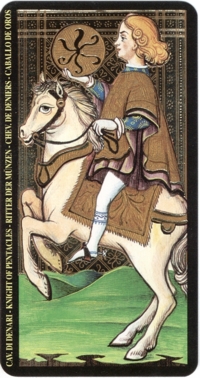|
Tarot Reflections |
August 15, 2003 |
|
Purchasing a
Visconti-Sforza Tarot Sherryl Smith |
||||
|
Several European publishers have reproduced the Pierpont-Morgan Bergamo Visconti Sforza deck, originally commissioned by the Duke of Milan in the 1450s. The most affordable is the shimmering gold deck published by Lo Scarabeo and distributed in the U.S. by Llewellyn. There are two editions - a stand-alone deck published in 2000, and a book-deck set produced in 2002. These decks have slight differences which I'll discuss below. Both Lo Scarabeo decks are printed on the same paper stock, and they both have an extra-wide left border with the suit or trump name printed in five languages. The lettering is white on the 2000 deck and gold on the 2002 deck. Both decks have stylized vegetation on the back– putty on the 2000 deck and olive with a horizontal bar across the center on the 2002 deck. The reversed Sforza motto on the 1, 2, and 4 of Rods and the 3 of Coins in the 2000 deck has been corrected in the 2002 version. The 2000 deck is smaller and more slender than most decks, in keeping with the original proportions. The 2002 deck is 3/10" (6 cm) wider and longer, giving it a somewhat awkward shape. The 2002 deck has more gold highlights, yet the 2000 deck appears richer because its colors are a few shades deeper. Four cards are missing from the original deck: 3 of Swords, Knight of Coins, Devil and Tower. Every publisher has commissioned an artist to re-create the missing cards. Your choice of deck will largely depend on your preference in replacement cards. The three of Swords follows the same pattern as other odd-numbered swords cards, so it looks the same in all decks.
All the court figures of one suit are supposed to be dressed in the same
color, but the 2000 Lo Scarabeo deck has the Knight of Coins in an
entirely different color. This is corrected in 2002, but the rendering of
the knight and his horse by artist A. A. Atanassov is very awkward.
Instead of filling the card as the other court figures do, the knight in
the 2002 deck is disproportionately small and his horse is less animated.
His outer tunic has no folds and looks like a triangular tent. The card
appears stiff and amateurish and does not blend with the other court
cards. |
|||
|
The earliest versions of the Devil and Tower cards known today are from block-printed cards from about 1500, so contemporary artists have to guess what these Visconti-Sforza cards might have looked like. Ideally, the replacement cards should historically correct and blend stylistically with the rest of the trumps. The Tower and Devil replacement cards for the Lo Scarabeo 2000 deck are close copies of the Rothschild sheet, woodblock cards printed about 1500. They are shown in Kaplan's Encyclopedia of Tarot Vol. I page 129. The Devil has horns, bat wings and bird claw feet. He is swallowing a person, and has a face protruding from his torso. This conventional depiction of the Devil is historically correct but can seem odd to modern Tarotists used to a different kind of Devil. The Tower card has a massive wall that fills the foreground. Flames leap from the tower, and there are two red suns in the top corners. Two falling figures are about to hit bottom in the center of the card. Atanassov's replacement cards for the Lo Scarabeo 2002 deck don't resemble any historical models. The Devil stands in flames instead of on a pedestal, and the two human figures are chained to each other instead of being chained to the pedestal. The Devil's body is long and graceful, with angelic-looking wings instead of the conventional stocky body and wide bat wings. The Tower is a slender column on a base with a domed cupola. Two figures fall to the ground while lightening splits the tower down one side. This is anachronistic since lightning doesn't appear on this card until the very late 16th century. AG Muller's photo-reproduction, distributed by US Games, is large (7"x 3.5") and faithfully reproduces the cards' current tack holes and peeling paint. The Knight of Coins blends with the other court cards, but the Devil and Tower are in Luigi Scapini's unmistakable style. Their bright colors and flowing lines do not blend with the rest of the deck Dal Negro and Il Meneghello have produced limited edition collector's decks with vibrant colors and well-designed replacement cards that are historically correct. The Devil has the conventional stocky body and bat wings. Fire attacks the Tower from a cloud in an upper corner. These decks can be seen online at: If you just want the pictures and don't need an actual deck, get The Visconti-Sforza Tarot Cards by Michael Dummett, published by George Braziller, 1986. It's an inexpensive paperback and out of print, but easily found on-line. Each card has a full-page color photo-reproduction with a short description on the facing page. |
||||
|
Subscribe to Tarot Reflections, and receive notification of each update! |
|
Request to be added to the list by sending email to TarotReflections-subscribe@yahoogroups.com! |
All articles remain the
property of their respective authors.
Tarot Reflections is a publication of the American Tarot Association
- Copyright (C) 2003
Questions or Comments? Contact Us.

